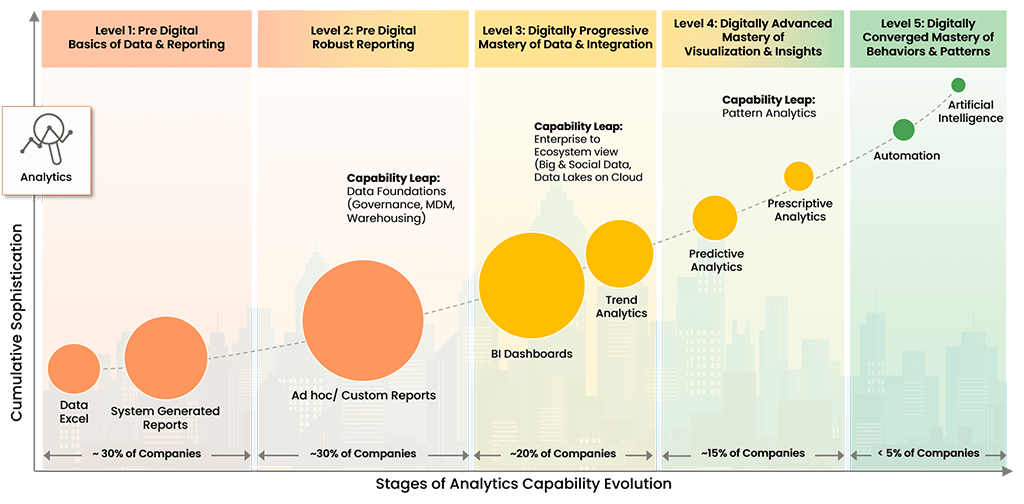Digitalizing Energy
More energy companies than ever are beginning to execute their digital transformation roadmap. These transformations must be enterprise-wide, transforming existing assets and products to drive innovation and remain competitive. New digital-first energy companies have a distinct advantage, shedding the weight of legacy systems and workflows in favor of agile, data-driven energy service provision. Legacy energy companies must transform quickly to maintain pace, or else risk being overshadowed by new and innovative digital-first competitors.
The high tech and telecom industries are poised to cut across the energy industry, providing products and services that augment the energy value chain. The electrification of industry, commerce, and transport operations is increasing electricity consumption, shifting the balance of energy supply demand. The energy industry must be aware of trends and regulatory changes, taking a proactive approach by adopting technology-driven processes to adapt and overcome the competition.
Only 7% of Companies Are Delivering on Their Transformational Initiatives
Our research has shown that 30% of companies will fail to survive this decade due to an inability to evolve digitally. To address this negative trend, we have developed the Digital Enterprise Evolution Model™ (DEEM).
Digital Enterprise Evolution Model™

Copyright © 2022 Trianz
DEEM allows our clients to recognize digital evolution patterns, implement benchmarking and prioritization strategies, and initiate application management protocols to satisfy stakeholder and market requirements.
Reimagining the Asset Value Chain
The energy industry must reimagine the asset value chain, including supply chain and distribution, the customer value proposition, and expectations for digital tools and services to manage consumer energy supplies.
Companies across the energy industry are recognizing the value of digitalization, both in terms of operational efficiency and insight, as well as delivering better customer experiences (CX). A new Energy-as-a-Service paradigm is emerging, with multiple providers in the same value chain providing greater stability and adaptability. Likewise, direct-to-consumer energy provision is gaining traction thanks to digital disruptors, threatening traditional energy delivery approaches with greater savings and energy ownership for consumers.
Around half of all energy enterprises are seeking to undergo a total digital transformation for these reasons. The goal is to reinvent the (CX) so as to remain competitive in an increasingly hostile digital energy services environment.
Energy Companies Outside the Vision-Driven Quadrant are at Risk
Energy companies have little room for error in terms of how they develop and implement new strategies. For companies who sit outside the vision-driven quadrant, they risk falling behind the pack. There is urgency to digitally transform in the energy industry, but a lack of excellence in execution may undermine the efforts of energy companies seeking to exploit the full value of digitalization.
As emerging players solidify their presence, established energy companies plan to optimize and transform their existing asset operations. The majority of this investment will be in analytics and process digitalization, enabling insight generation and robotic process automation (RPA), which can both improve operational efficiency. Technologies like digital management tools and the Internet of Things (IoT) will usher in a new era of smart, integrated oilfields and energy grids; an essential change that will unveil new opportunities for profit and company positioning in the market.
Energy Leadership in Supply Chain Practices
The energy industry sets the bar for efficient and effective supply chain practices. It has the highest planned digitalization investment in terms of processes, with research and development around applied analytics catalyzing this movement further.
Future energy technologies will include advanced analytics and AI-based automation, with present research and development in these areas outpacing all other functions in the energy industry. This accentuates the need for a vision-driven approach to digitalization among energy companies. Similarly, it highlights growing vulnerabilities among energy companies who sit outside the vision-driven quadrant.
Experience the Trianz Difference
Trianz enables digital transformations through effective strategies and excellence in execution. Collaborating with business and technology leaders, we help formulate and execute operational strategies to achieve intended business outcomes by bringing the best of consulting, technology experiences and execution models.
Powered by knowledge, research, and perspectives, we enable clients to transform their business ecosystems and achieve superior performance by leveraging infrastructure, cloud, analytics, digital and security paradigms. Reach out to get in touch or learn more.





















